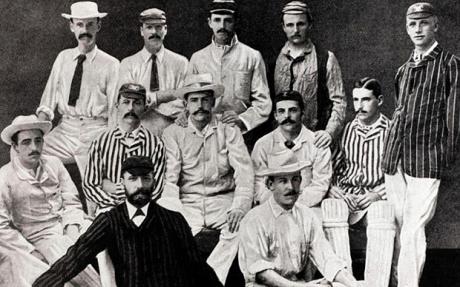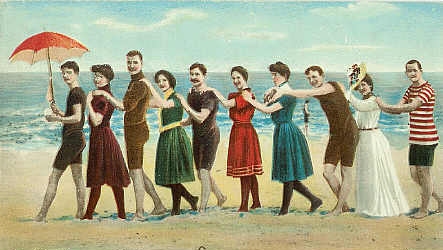A chucklesome comment from Sali Lamo, New Yorker cartoonist: “Not to be a downer or anything, but Michael Jackson’s dying is really going to hurt the credibility of the hyperbaric-oxygen-chamber industry.”
Which is an insightful and previously neglected thought; although I would say this: people didn’t seem to be put off running when the health convert Jim Fixx, doyen of jogging, dropped dead from a heart attack at the age of 52.

Even now you can’t throw a plimsoll in Central Park, Hyde Park, Stanley Park or Albert Park without it bouncing off the cranium of somebody sweatily loping around its perimeter. And at times it seems that there are more people at any one time taking part in marathons around the world’s great cities than laying on the couch watching them.
Death can kindly stop for anyone, though, and slowly drive them off in his carriage. His lifetime-sized hourglass currently hangs over Patrick Swayze; and he has previously transported away Syd Barrett, Luciano Pavarotti, Rene Magritte, Dizzy Gillespie, Randy Pausch and Bill Hicks in the glossy landau he calls ‘Pancreatic Cancer’.

This coach usually draws up alongside octo- and septuagenarians but can also squeak to a halt alongside the young and healthy. Nobody really knows why. Pancreatic cancer is not genetic. Bill Hicks blamed it on his energetic smoking, which certainly cannot have helped; yet Keith Richards still somehow walks the earth, while Randy Pausch never let a cigarette pass his lips.
Professor Pausch was a computer science lecturer and researcher at Carnegie Mellon whose ‘last words’ were an inspiring ‘Last Lecture‘. Which I’ll get around to watching and getting inspired by at some point. Before I die, let’s say.
The last words of Bill Hicks were a more pithy “I’ve said all I have to say” on Valentine’s Day 1994. And he was as good as his word, staying silent for his final twelve days on this world.

To come full circle, though, here are some of the great(est) comedian’s thoughts on the subject at hand:
“Does anyone remember this, when Yul Brynner died, and came out with that commercial after he was dead? ‘I’m Yul Brynner and I’m dead now.‘
What the fuck’s this guy selling? I’m all ears.
‘I’m Yul Brynner and I’m dead now, because I smoked cigarettes.’
Okay, pretty scary. But they coulda done that with anybody. They coulda done it with that Jim Fixx guy, too, just as easily. Remember that guy, that health nut who died while jogging? I don’t remember seeing his commercial. ‘I’m Jim Fixx and I’m dead now. And I don’t know what the fuck happened. I jogged every day, ate nothing but tofu, swam five hundred laps every morning, and I’m dead. Yul Brynner drank, smoke, and got laid every night of his life… he’s dead.
Shit.
Yul Brynner’s smokin’, drinkin’, girls are sitting on his cueball noggin every night of his life! I’m running around a dewy track at dawn. And we’re both fuckin’ dead. Goddammit.
Yul used to pass me on his way home in the morning, big long limousine, two girls blowing him, cigarette in one hand, drink in the other. “One day that life is going to get to you, Yul.” ‘
They’re both dead. Yeah, but what a healthy looking corpse you were, Jim. Look at the hamstrings on that corpse! Look at the sloppy grin on Yul’s corpse! Yul Brynner lived his life. Sure, he died a 78-pound stick figure, okay. There are certain drawbacks.”
‘I’m Yul Brynner and I’m dead now.’
What the fuck’s this guy selling? I’m all ears.
‘I’m Yul Bryner and I’m dead now, because I smoked cigarettes.’
Okay, pretty scary. But they coulda done that with anyone. They coulda done it with that Jim Fixx guy, too, remember that guy, that health nut who died while jogging? I don’t remember seeing his commercial!
‘I’m Jim Fixx and I’m dead now. And I don’t know what the fuck happened. I jogged every day, ate nothing but tofu, swam five hundred laps every morning, and I’m dead. Yul Bryner drank, smoke, and got laid every night of his life… he’s dead. Shit! Yul Bryner’s smokin’, drinkin’, girls are sitting on his cueball noggin, every night of his life! I’m running around a dewy track at dawn. And we’re both fuckin’ dead. Yul used to pass me on his way home in the morning, big long limousine, two girls blowing him, cigarette in one hand, drink in the other. “One day that life is going to get to you, Yul.”‘
They’re both dead. Yeah, but what a healthy looking corpse you were, Jim. Look at the hamstrings on that corpse! Look at the sloppy grin on Yul’s corpse! Yul Bryner lived his life. Sure, he died a 78-pound stick figure, okay. There are certain drawbacks.”












 Thanks to
Thanks to